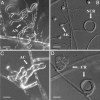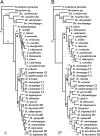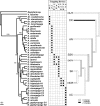Evolution of nematode-trapping cells of predatory fungi of the Orbiliaceae based on evidence from rRNA-encoding DNA and multiprotein sequences
- PMID: 17494736
- PMCID: PMC1895958
- DOI: 10.1073/pnas.0702770104
Evolution of nematode-trapping cells of predatory fungi of the Orbiliaceae based on evidence from rRNA-encoding DNA and multiprotein sequences
Abstract
Among fungi, the basic life strategies are saprophytism, parasitism, and predation. Fungi in Orbiliaceae (Ascomycota) prey on animals by means of specialized trapping structures. Five types of trapping devices are recognized, but their evolutionary origins and divergence are not well understood. Based on comprehensive phylogenetic analysis of nucleotide sequences of three protein-coding genes (RNA polymerase II subunit gene, rpb2; elongation factor 1-alpha gene, ef1-alpha; and ss tubulin gene, bt) and ribosomal DNA in the internal transcribed spacer region, we have demonstrated that the initial trapping structure evolved along two lineages yielding two distinct trapping mechanisms: one developed into constricting rings and the other developed into adhesive traps. Among adhesive trapping devices, the adhesive network separated from the others early and evolved at a steady and gentle speed. The adhesive knob evolved through stalk elongation, with a final development of nonconstricting rings. Our data suggest that the derived adhesive traps are at a highly differentiated stage. The development of trapping devices is felicitous proof of adaptive evolution.
Conflict of interest statement
The authors declare no conflict of interest.
Figures




References
-
- Pramer D. Science. 1964;144:382–388. - PubMed
-
- Li TF, Zhang KQ, Liu XZ. Taxonomy of Nematophagous Fungi. Beijing: Chinese Scientific and Technological Publications; 2000.
-
- Pfister DH. Mycologia. 1997;89:1–23.
-
- Rubner A. Stud Mycol. 1996;39:1–134.
-
- Barron GL. The Nematode-Destroying Fungi. Topics in Mycobiology I. Guelph, Canada: Canadian Biological; 1977.
Publication types
MeSH terms
Substances
LinkOut - more resources
Full Text Sources
Other Literature Sources

